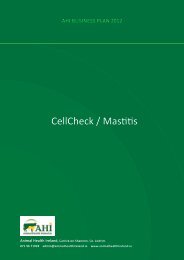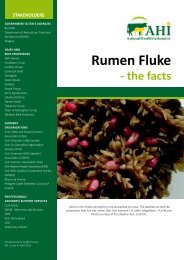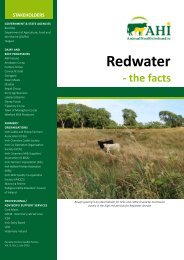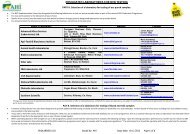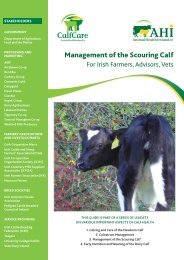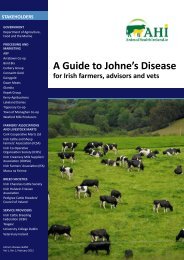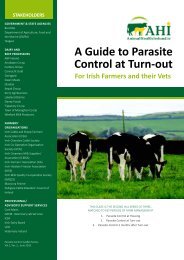Calving and Care of the Newborn Calf - Animal Health Ireland
Calving and Care of the Newborn Calf - Animal Health Ireland
Calving and Care of the Newborn Calf - Animal Health Ireland
You also want an ePaper? Increase the reach of your titles
YUMPU automatically turns print PDFs into web optimized ePapers that Google loves.
7<br />
Remove <strong>the</strong> dairy calf from <strong>the</strong> cow<br />
Once <strong>the</strong> calf is born, it is at immediate risk <strong>of</strong> picking up infections via <strong>the</strong> navel, mouth <strong>and</strong> nostrils from<br />
<strong>the</strong> calving environment, <strong>the</strong> cow <strong>and</strong> any o<strong>the</strong>r animals in <strong>the</strong> same airspace.<br />
Hence, <strong>the</strong> dairy calf should be removed from <strong>the</strong> cow immediately after birth (<strong>the</strong> cow can be allowed to<br />
lick <strong>the</strong> calf) <strong>and</strong> placed in a clean, freshly-bedded area where it is fed colostrum. (See AHI leaflet -<br />
‘Colostrum Management' for fur<strong>the</strong>r details).<br />
Safety at calving<br />
A quarter <strong>of</strong> Irish farm accidents <strong>and</strong> one fifth <strong>of</strong> farm deaths in older farmers are livestock-related. Attacks<br />
by recently calved cows are a common cause <strong>of</strong> such accidents. In addition, zoonotic infections can be<br />
contracted by farmers <strong>and</strong> <strong>the</strong>ir vets around calving.<br />
• When h<strong>and</strong>ling cows at calving (particularly if <strong>the</strong>y are calving prematurely or if <strong>the</strong> calf is dead a while)<br />
always wear arm length gloves <strong>and</strong> washable protective clothing <strong>and</strong> boots.<br />
• When h<strong>and</strong>ling <strong>the</strong> newborn calf never turn your back on <strong>the</strong> cow <strong>and</strong> always keep a locked gate<br />
between you <strong>and</strong> <strong>the</strong> cow when removing <strong>the</strong> calf.<br />
Preventing NAVEL ILL<br />
Use<br />
correct navel<br />
care routine<br />
Check regularly for navel ill –<br />
h<strong>and</strong>le <strong>the</strong> navel <strong>of</strong> all calves with<br />
clean or gloved h<strong>and</strong>s at birth<br />
<strong>and</strong> in <strong>the</strong> first week <strong>of</strong> life to<br />
check for excessive bleeding,<br />
pain, abnormal swelling, odour or<br />
pus <strong>and</strong> treat as recommended<br />
by your local vet.<br />
If you have problems with navel ill in your calves it<br />
is important to see <strong>the</strong> ‘big picture’ <strong>and</strong> not to focus<br />
only on cord care as <strong>the</strong> answer to <strong>the</strong> problem. The<br />
cause <strong>of</strong> navel ill is infection spreading from <strong>the</strong><br />
environment into <strong>the</strong> calf via <strong>the</strong> navel cord.<br />
To prevent navel ill you need to address all risk<br />
factors that lead to high contamination <strong>of</strong> <strong>the</strong><br />
environment <strong>and</strong> low immunity <strong>of</strong> <strong>the</strong> calf:<br />
• improve calf immunity: ensure <strong>the</strong> newborn calf<br />
gets an adequate volume <strong>of</strong> good quality<br />
colostrum as soon as possible after calving<br />
(see AHI leaflet- 'Colostrum Management')<br />
• ensure calves are born in a clean, freshly bedded<br />
calving unit<br />
Treat navel immediately after calf<br />
is born<br />
Check to ensure total coverage <strong>of</strong> <strong>the</strong> navel cord



